Business Community
Artondale firm competes with Big Boys of SpaceTech
With this state’s vibrant space technology sector, it’s no surprise that NASA in 2023 chose three Washington companies for its NASA Innovative Advanced Concepts (NIAC) program, which provides seed funding to nurture early-stage ideas that could transform future space missions.
Washington firms awarded the highly competitive NIAC slots, each with a $175,000 grant, include a Ph.D-led Seattle corporation that has so far raised $49.75 million to back its ideas. Another is a Seattle company with founders hailing from internationally-known space labs and from Elon Musk’s SpaceX.
The third? It’s a tiny Gig Harbor firm, led by a guy with a GED who is working out of his house in Artondale.
Quinn Morley, 39, and his company, Planet Enterprises, lack the headcount, deep pockets and advanced degrees of many their SpaceTech counterparts. But if NASA’s enthusiasm for his ideas are any indication, Morley and his firm make up for it with something the space program prizes more: Dramatically innovative, technically credible ideas, put forth by investigators judged capable of determining if they’ll actually work.
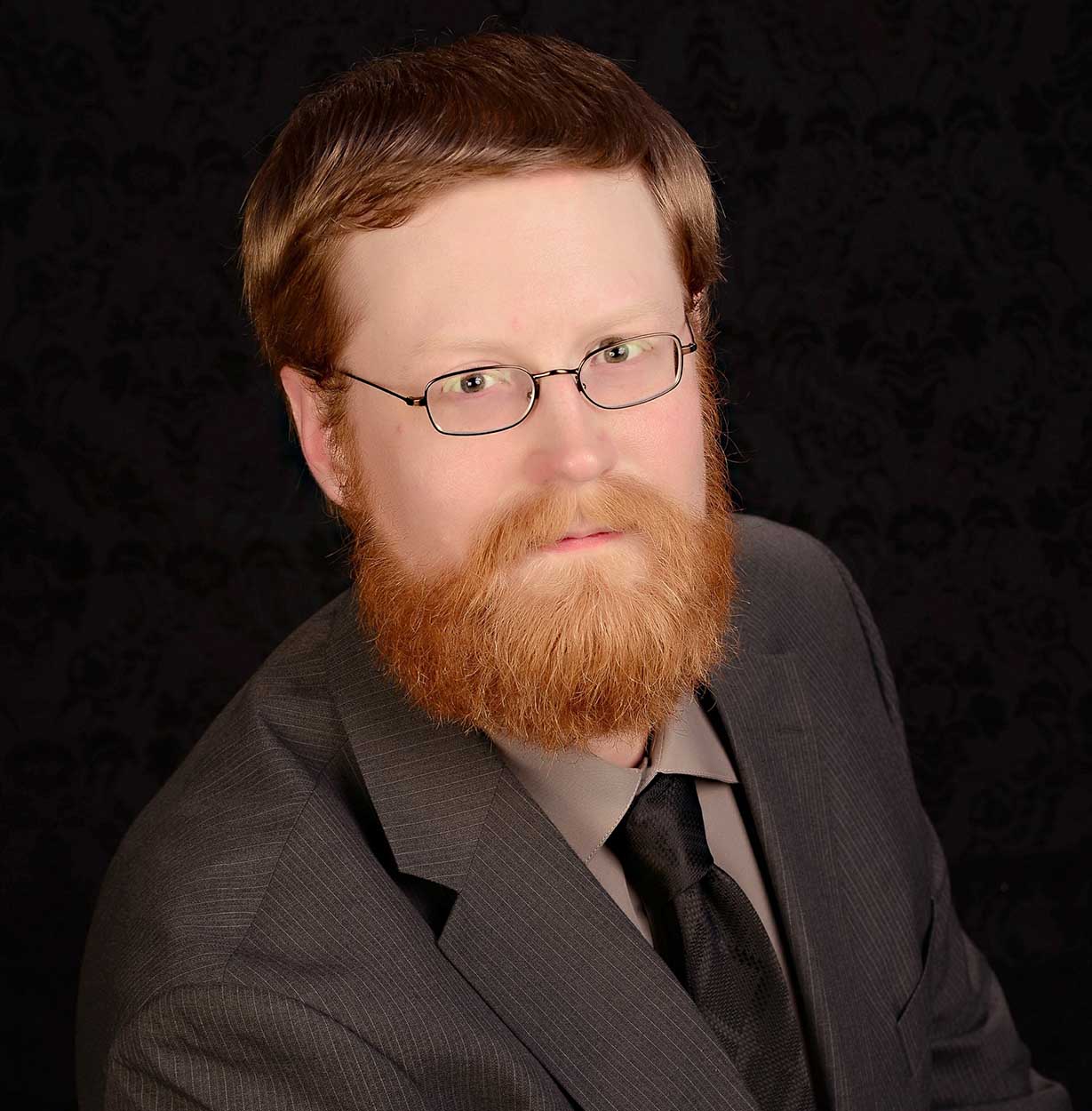
Quinn Morley
‘Far down the road’
More specifically, NIAC chooses its fellows (the principal investigators for NIAC projects) based on their abilities to identify and tease out early-stage concepts that, if shown feasible through the program, carry the potential to deliver breakthroughs for space missions.
“A lot of this stuff is looking really far down the road,” said John Nelson, NIAC deputy program executive. “We are not looking for incremental change, we are looking for transformative change.”
On that basis, Morley has measured up well. With the support of his research collaborators on each project, he earned NIAC grants for two proposals. Morley is the only undergraduate to earn this fellowship in the history of the program — and he’s done it twice.
Borebots
The first concept, chosen for a NIAC Phase 1 fellowship in 2021, envisions technology to radically advance deep-ice drilling in Mars’ ancient South Pole Layered Deposits. Planet Enterprises proposes “borebots” — or tether-less, self-driving drilling robots. They would “drive up and down the borehole with flexible tracks that are ‘squish-fit’ against the bore wall.” A standby borebot would swap in when the active one needs maintenance or repair.
The goal is to bore through the cement-like polar surface and down through layers of ice and dust as far as 50 meters, where scientists believe they may find a liquid water lake. The borebots would ‘live’ aboard a Mars rover, turning that vehicle into a mobile polar drilling rig.
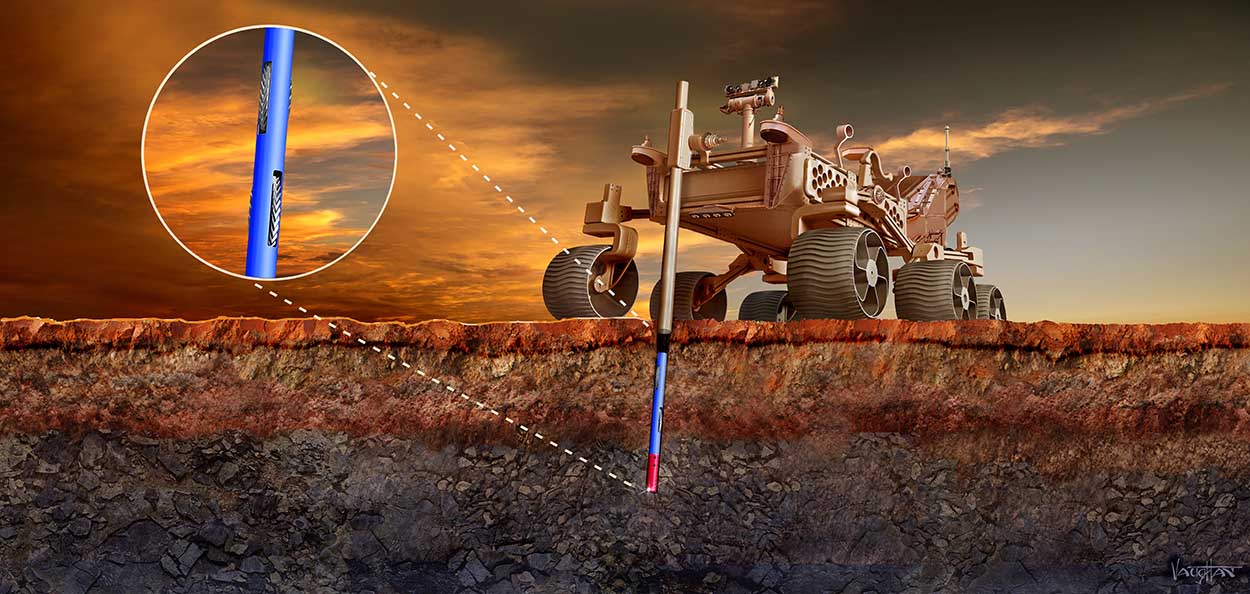
The Autonomous Robotic Demonstrator for Deep Drilling project aims to rapidly advance Mars deep ice drilling technology. The ‘borebot’ would drive up and down the bore hole with flexible tracks that are ‘squish-fit’ against the bore wall. Photo illustration by James Vaughan
If the borebots succeed in their primary goal of extracting ice cores for analysis down to the target depth, the benefit to science “would be virtually unrivaled in Mars exploration,” Planet Enterprises’ final paper from the project states.
“Just centimeters below the surface there may be frozen life, alive or dead.” Just the drilling and imaging that would occur inside the boreholes “would dramatically change our knowledge of the climate and geophysical history of Mars on a time scale of millions of years.”
TitanAir
Planet Enterprises’ second project, nicknamed TitanAir and accepted by NIAC in January, goes even farther afield (astronomically speaking), to Titan, Saturn’s largest moon. Titan has long intrigued scientists with its dense atmosphere, clouds and Earthlike systems of lakes, rivers and seas made of liquid hydrocarbons.
To gather and analyze these liquids and gases, Planet Enterprises proposes a flying boat-like craft — the “flying laker” — that soars through Titan’s atmosphere up to one hour per day and lands on its methane lakes. The flyer aims to “ ‘drink’ in methane condensation and organic material through a permeable section of its leading edge wing skin,” Planet Enterprises’ website says. “Capillary features on the inside of the wing will collect this ingested material and combine it into a continuous fluid stream, which can then be routed to science instruments inside the flyer.”
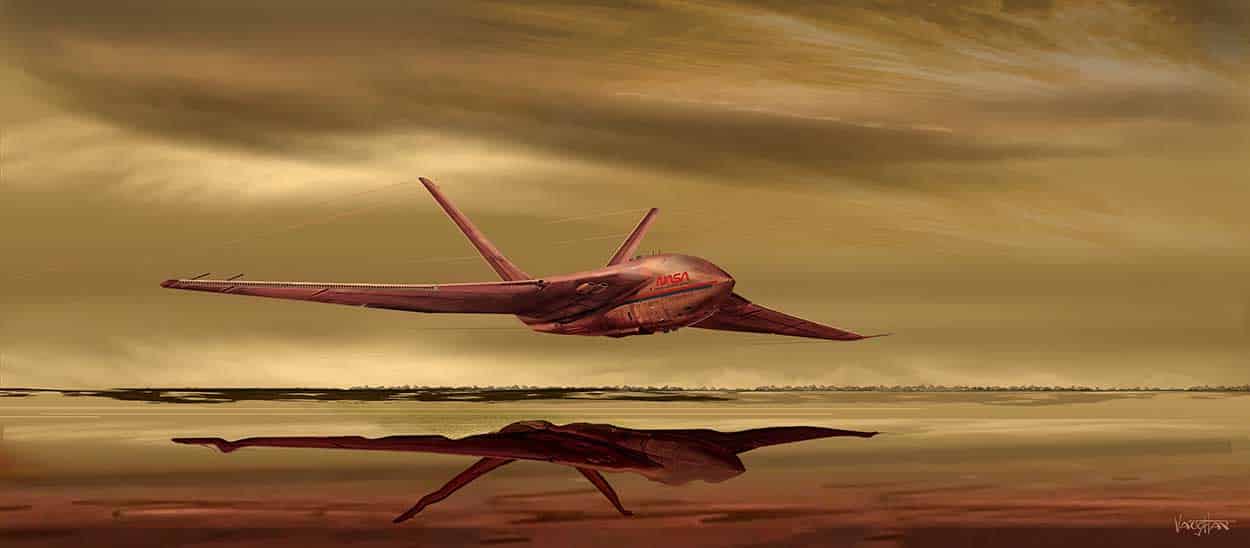
The Titan Flyer concept aims to ‘drink’ from the methane lakes of Saturn’s moon, Titan. The flying boat-like vehicle would ingest methane condensation and organic material through a permeable section of the leading edge wing skin. Photo illustration by James Vaughan
Dead ends
Morley may have been a college student when he hatched this idea, but he was no kid. In fact, his path to the NIAC principal investigator role took two decades and included zigs and zags, as well as a dead end or two.
“I’m a high school dropout, and I also dropped out of TCC (Tacoma Community College), failing math three times,” Morley said. A Key Peninsula native, he attended Peninsula High School, but lacked motivation and skipped classes. He loved reading science fiction, though. “I remember watching Cosmos, observing the (NASA Mars) Sojourner rover getting stuck on the Yogi (a Mars rock), and of course, watching Star Trek: The Next Generation and all-day Star Wars binges.”
In the 2000-2001 school year, Morley and some friends noticed a Small Business Innovation Research call for proposals from the Navy seeking a new super-fast torpedo propulsion system. The group submitted a white paper: “Dynamic Compression Valveless Pulsejet Propulsion System for High Speed Super-Cavitating Undersea Weapons”.
“We got turned down, of course,” Morley recalled. But if nothing else, the project planted a seed and led him to start a company with a name, Planet Enterprises.
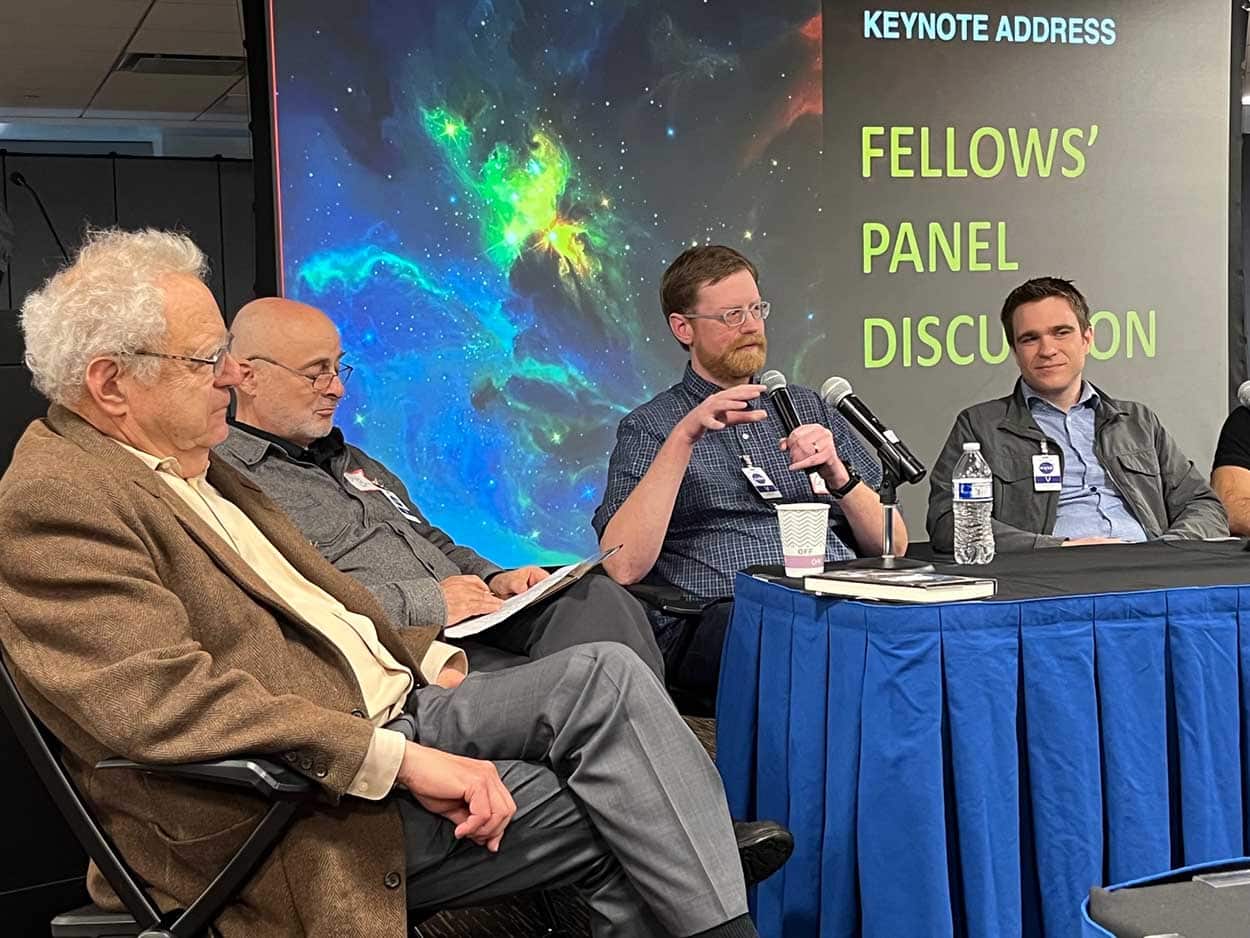
Quinn Morley (second from right) onstage at a NASA Innovative Advanced Concepts (NIAC) orientation for Phase I fellows in Washington D.C., March 22, 2023. Photo by NASA
A winding road
Even before the Navy’s rejection, Morley had withdrawn from Peninsula High.
“My support network allowed me to drop out and fall on my face, continuing to support me as I found random jobs,” he said. “No one ever pushed me towards engineering during this period. I doubt I would have listened.” (He did earn his General Educational Development certificate around this time.)
After stints at TCC, Morley applied to Boeing and completed an unpaid 160-hour training program in Everett, making him eligible for the assembly mechanic lottery. He started work in May 2008, landing a few years later in the company’s Blue Streak mechanic program. On Boeing’s dime, Morley enrolled at Olympic College in Bremerton where he started passing math classes (he credits the instructor).
In 2020, Morley entered the Washington State University mechanical engineering program on the Olympic College campus. With two accepted NIAC proposals under his belt, he graduated with a bachelor of science degree in spring 2023.
By that point, Morley had left Boeing, disillusioned.
“There is a lot of unhelpful influence in our culture from Wall Street and the business schools, like performance reviews. When you are an effective leader, you don’t need to see the performance reviews of your employees. You need to work with your employees, and empower them.” Morley blames Boeing’s top-down approach for a failure of communication that fed the company’s MAX crisis. Technical workers feared telling higher-ups about design problems, he said.
Boutique company
That’s a management mistake Morley vows to avoid as he grows Planet Enterprises. In 2024, “I want to put together a small team and really focus on developing them as creative engineers, and have them on-site at least a few days a week,” he said.
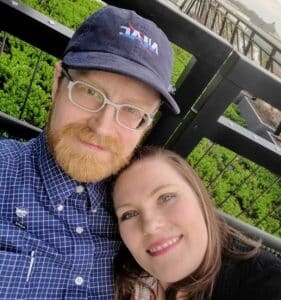
Quinn Morley and his wife, Melissa Downing
“This company will always be a boutique technology development/consulting company. The real goal is to put together a small, core team of people that like using their creativity to move high-risk projects closer to reality. If a billion-dollar idea came out of that, it would probably end up as a spin-off company,” Morley said.
Without venture capital investors or executives with MBAs urging him on, how will Planet Enterprises’ path differ from some other space technology startups chasing NIAC grants and even bigger funding?
“You are asking if in the mirror universe I would be beating the pavement and pounding on oak boardroom tables to get millions in investments, thereby getting locked into filing 600 patents a year,” Morley said. “I’d rather be locked in an Agony Booth.”

